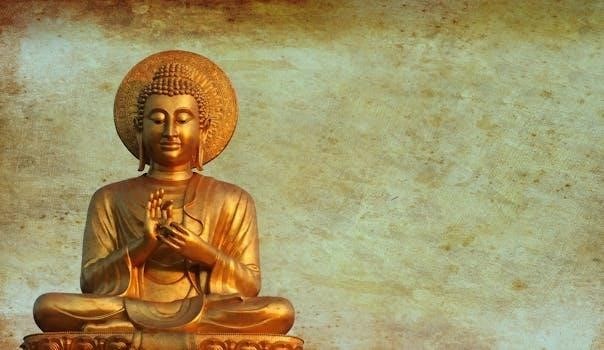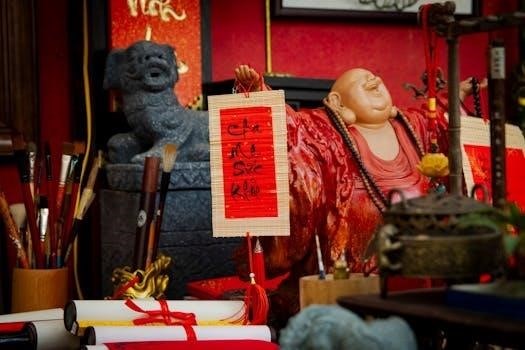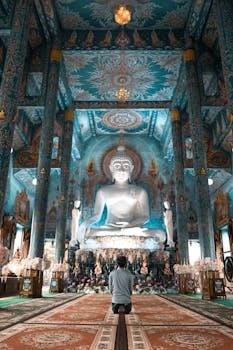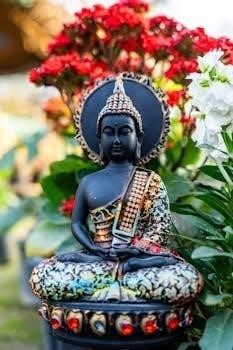buddha mudras pdf
Buddha Mudras are symbolic hand gestures that hold profound spiritual meaning in Buddhism. These gestures, often seen in statues and art, represent specific moments in Buddha’s life and convey deep spiritual concepts. They are more than mere aesthetics, channeling energy and evoking particular states of mind.
What are Buddha Mudras?
Buddha Mudras are specific hand positions and gestures that hold symbolic meaning within Buddhist traditions. Derived from the Sanskrit word meaning “seal” or “sign,” these mudras are not merely decorative; they are powerful tools used to express spiritual states, convey teachings, and invoke particular energies. They are a visual language that communicates deep concepts and stories related to Buddha’s life and enlightenment. Each mudra is associated with a specific posture of the hands, fingers, and sometimes even the entire body. These gestures are found in Buddhist art, sculpture, and are also practiced during meditation and rituals to facilitate focus and connection with the divine. The use of mudras enhances spiritual practice and helps deepen understanding of Buddhist philosophy. They serve as a visual aid, helping practitioners embody the meaning behind each gesture.

Significance of Mudras
Mudras are not just hand gestures; they are powerful symbols that hold deep meaning in Buddhism. They represent key moments in Buddha’s life, embody spiritual principles, and facilitate meditation and rituals. They are a visual language of enlightenment.
Mudras as Symbols of Meaning
Mudras serve as potent symbols, each carrying a specific meaning within Buddhist tradition. They are not arbitrary gestures but rather a visual language that communicates profound spiritual concepts and narratives. These hand positions often reference key events from the life of the Buddha, encapsulating teachings, states of mind, and principles such as compassion, wisdom, and fearlessness. For example, a mudra might represent the moment of enlightenment or the act of teaching the Dharma. The use of mudras allows practitioners to connect with these meanings on a deeper level, aiding in meditation and ritual practices. They are considered a powerful tool for focusing the mind and channeling energy, making them an integral part of Buddhist art and spiritual practice, conveying profound messages through simple yet eloquent hand gestures.
Mudras and Spiritual States
Beyond their symbolic meanings, mudras are intrinsically linked to various spiritual states. These hand gestures are believed to evoke specific mental and emotional conditions in both the practitioner and the observer. For instance, a mudra associated with meditation helps to foster a calm and focused mind, while a gesture of fearlessness can instill courage and confidence. The use of mudras in meditation and rituals is not merely a physical act; it is a practice that aims to synchronize the body, mind, and spirit. By adopting these gestures, one can attune themselves to the particular energy and state of consciousness that the mudra embodies. This connection allows for a deeper understanding of Buddhist principles and promotes spiritual growth, facilitating a harmonious balance between the physical and the metaphysical.

Common Mudras and Their Meanings
There are several common mudras found in Buddhist art, each with a distinct meaning. These gestures represent specific moments and teachings from Buddha’s life, symbolizing concepts like wisdom, compassion, and enlightenment. Each mudra holds a unique significance.
Bhumisparsha Mudra (Touching the Earth)
The Bhumisparsha Mudra, often referred to as the “earth-touching” gesture, is a powerful symbol representing the moment of Buddha’s enlightenment. This mudra depicts the Buddha with his right hand reaching down, palm inward, to touch the earth, while the left hand rests in his lap. This gesture symbolizes the Buddha calling upon the Earth to witness his victory over Mara, the demon of illusion and temptation. It signifies unwavering resolve and the grounding of spiritual realization in the physical realm. This mudra is one of the most common and significant gestures found in depictions of the Buddha across various Buddhist traditions. It emphasizes the importance of overcoming obstacles on the path to enlightenment and the unwavering commitment to truth and compassion.
Dhyana Mudra (Meditation)
The Dhyana Mudra, also known as the Meditation Mudra or Yoga Mudra, is a serene and common gesture representing profound concentration and inner peace. Typically, this mudra is depicted with both hands resting on the lap, the right hand placed on top of the left, with palms facing upwards and fingers fully extended. This hand position symbolizes the state of deep meditation, where the mind is calm and focused. It’s often seen in representations of Buddha Shakyamuni, Dhyani Buddha Amitabha, and Medicine Buddhas. The Dhyana Mudra signifies the cultivation of inner stillness, tranquility, and the harmonious balance of body and mind. This gesture is a reminder of the importance of mindfulness and introspection on the path to spiritual awakening, embodying the essence of meditative practice.
Abhaya Mudra (Fearlessness)
The Abhaya Mudra, a powerful gesture, embodies fearlessness and protection. Typically, this mudra is represented with the right hand raised, palm facing outwards, and fingers pointing upwards, while the left hand hangs naturally by the side of the body. This gesture, often depicted in both standing and seated Buddha statues, signifies the dispelling of fear and the granting of reassurance. The Abhaya Mudra is not just a physical gesture; it also symbolizes the inner courage and confidence that comes from spiritual awakening. It represents the Buddha’s ability to overcome all obstacles and challenges, offering solace and a sense of security to those who seek it. It inspires practitioners to face their own fears and to walk the path of enlightenment with unwavering resolve.
Dharmachakra Mudra (Teaching)
The Dharmachakra Mudra, often referred to as the “Wheel of Dharma” Mudra, symbolizes one of the most pivotal moments in the Buddha’s life – his first sermon after achieving enlightenment. This mudra is characterized by both hands held in front of the chest, with the tips of the index fingers and thumbs touching, forming a circle. This circle represents the turning of the wheel of Dharma, signifying the beginning of the Buddha’s teachings. It embodies the concept of knowledge, wisdom, and the propagation of the path to enlightenment. The Dharmachakra Mudra is a powerful reminder of the importance of sharing wisdom and guiding others towards spiritual awakening. It represents the act of teaching and the transmission of the Buddha’s message to the world.
Varada Mudra (Generosity)
The Varada Mudra is a gesture of giving, representing generosity, compassion, and the fulfillment of wishes. This mudra is typically depicted with the hand, usually the right, extended downward, with the palm facing outwards. The fingers may be slightly curved or fully extended, symbolizing the act of bestowing blessings and granting boons. It embodies the concept of openness and a willingness to offer help to others. The Varada Mudra is a powerful symbol of the Buddha’s boundless compassion and his desire to alleviate suffering. It serves as a reminder of the importance of generosity, charity, and selflessness. It is often seen in depictions of Buddha, particularly in those associated with compassion and the granting of wishes. This gesture is a beacon of hope and kindness, encouraging devotees to embrace these qualities.

Mudras in Practice
Mudras are actively used in Buddhist meditation and rituals. They are not just symbolic gestures; they are tools to focus the mind and enhance spiritual practice. They help practitioners connect with the deeper meaning of Buddhist teachings.
Mudras in Meditation and Rituals
In the practice of Buddhism, mudras play a vital role in both meditation and ritualistic ceremonies. These sacred hand gestures are not merely aesthetic additions but are considered potent tools that enhance focus and deepen the practitioner’s connection to spiritual truths. During meditation, specific mudras are adopted to help channel energy, calm the mind, and evoke particular states of consciousness associated with enlightenment. The use of mudras in rituals serves a similar purpose, acting as a visual representation of the spiritual principles being invoked. Monks and nuns often utilize these gestures to generate forces that amplify the ritual’s intent and invoke the blessings of deities. The precise hand positions are believed to facilitate a deeper understanding of Buddhist teachings and help the practitioner align with the universal energies. By incorporating mudras, practitioners engage not only their minds but also their bodies in the pursuit of spiritual awakening, creating a holistic experience that elevates the efficacy of their practice.

Additional Aspects of Mudras
Beyond their symbolic meanings, mudras are also connected to the five elements, each finger representing a different element. This adds another layer of depth, linking the physical gestures to the cosmic forces of the universe.
Mudras and the Five Elements
The practice of mudras extends beyond mere hand gestures; it delves into the connection between the human body and the fundamental elements of the universe. In this context, each finger is believed to correspond to one of the five elements⁚ fire, air, space, earth, and water. The thumb represents fire, symbolizing energy and transformation. The index finger embodies air, associated with movement and intellect. The middle finger corresponds to space, representing vastness and consciousness. The ring finger signifies earth, grounding stability and material existence. Finally, the little finger embodies water, linked to fluidity and emotions. This intricate system of correspondence adds a deeper layer of understanding to the practice of mudras, suggesting that these gestures aren’t just symbolic but also active means of engaging with the elemental forces of the cosmos. By consciously positioning their fingers, practitioners can influence these elements within themselves and their surroundings, fostering a sense of harmony and balance.
